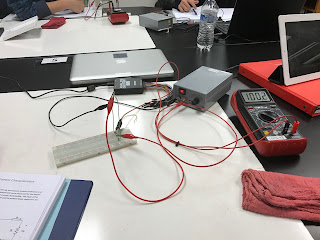Dependent sources and MOSFET
In this part of todays activities we figure out the SI units for ohms which is associated with the resistance in a circuit. We begin with the basic understanding of ohms which is voltage over amperes and further expand on those followed by simplifying to get the SI units for resistance.
In this part of the activity we take a look at the the first basic law of electrical circuits which is known as Ohm's law. We also take a look at how the resistance of a resistor is determined. As we can see from the picture there is a specific value that is used as the coefficient. This value is unique to different materials. The resistance is also determined by the geometry of the resistor. The geometry is important because this determines how many electrons can flow which is responsible for voltage difference. This voltage difference is what is measure on a voltmeter.
This is the first part of the lab in which we are measuring the voltage directly from a DC power source. There is a change in the voltage because as we learned the breadboard has internal resistance.
Here we are taking the resistance of a resistor.
In this picture we write down the resistance that was measure for the resistor and the new voltage output when this resistor was implemented into the circuit.
In this example we take a look at the relationship between nodes, branches, and loops. An important concept is that a branch is essentially determined by a component. For example, if there were two components in series this would result in there being two branches in that series of components. This most likely has to do with the fact that there is voltage drop for every component in a circuit because each component has internal resistance.
In the above example, we do our first practice with Kirchhoff's law. Using loops we tried to determine the voltage out which in this circuit is the voltage across the points a and b. By using loops we are essentially relating the voltage of all the components. Some components have independent voltages like the 30V supply while others have dependent sources which are not present in this circuit.







No comments:
Post a Comment